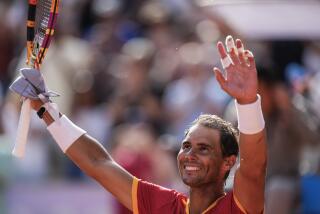Player Absences Affect Matches
- Share via
Tim Henman won’t make the trip to Tel Aviv for Britain’s Davis Cup matches against host Israel, and it’s not because of the first two thoughts that come to mind: security concerns and suicide bombers.
Roger Federer won’t play Davis Cup for the first time in six years, leaving Switzerland’s Davis Cup first-round fortunes against the Netherlands possibly in the nervous hands of Stanislas Wawrinka.
Then there are the guys you may have seen not long ago spraying champagne around a clay court in front of 27,000 at Seville, Spain: Carlos Moya and Juan Carlos Ferrero. Davis Cup champions in December, Moya and Ferrero will be no-shows for the first round at Slovakia, starting Friday. Ferrero has been slowed by injuries.
What once was considered largely an American problem appears to have gone global.
“I always said the reason the players played Davis Cup was that they feared being criticized if they didn’t play,” said Charlie Pasarell, tournament director of the Pacific Life Open and a member of the U.S. Davis Cup team in the 1960s and mid-1970s.
Those days seem long over.
U.S. Davis Cup captain Patrick McEnroe, who brought Andre Agassi back into the fold after nearly a five-year absence, understands the push-and-pull of the crowded modern-day schedule.
“The reason they’re not playing is not because they don’t care about representing their country, it’s just that at some point it’s too much,” he said. “At some point, all the responsibilities of being a top player, for better or worse, it’s just a fact. You can argue all you want, ‘They should still play for their country no matter what.’
“I would love them to do that. Imagine if Agassi had played the last four years, we probably could have won this thing once or twice. But that doesn’t happen.”
An International Tennis Federation official said that the individual player cases of 2005 did not represent a larger issue of concern, citing unique circumstances for each, and that the Davis Cup committee looks at the format and its pluses and minuses on a regular basis.
McEnroe said he could “bang my head against the wall,” and go to captains’ meetings and state his opinions.
“I try not to think too much about that bigger picture because I’m going to get too frustrated. So I’m just going to be happy we’ve got a good thing going,” he said.
McEnroe’s ESPN colleague, Cliff Drysdale, sounded a similar theme when asked about the chances of a Davis Cup format change, a way to streamline the competition and heighten its importance, saying: “I’m afraid we’re beating our heads against the wall.”
But U.S. Tennis Assn. officials and American media aren’t the only ones suggesting changes. In 2004, Australia captain John Fitzgerald proposed that the Davis Cup finalists receive a first-round bye the next year. His suggestion came after Sweden defeated Australia in the first round last year, only 70 days after the Australians had won the 2003 Davis Cup against Spain.
ITF officials shot down that idea, saying that reduction in competition was the exact opposite of what it wanted. For every complaint, the ITF can point to wildly successful events such as the 2004 final in Seville, or the historic visit in 2000 by then-captain John McEnroe and Agassi to Harare, Zimbabwe. Even Agassi was guarded about making sweeping changes without considering the downside for smaller nations.
The USTA’s Arlen Kantarian views the Davis Cup as the definition of untapped opportunity, calling it the “most under-leveraged” property in the sport.
“This could be like the Ryder Cup,” said Kantarian, the organization’s visionary. “We’ve got to think about not how great it is today but how big it could be for tennis.”
He advocated a final-four format every two years -- in odd years, as to not conflict with the Olympics -- but wouldn’t want to take away from the event’s special home-and-away flavor in earlier rounds.
Then there’s the problem of continuity. Officials at the USTA already were planning for the first round against Croatia -- Friday through Sunday at the Home Depot Center -- during the 2004 final against Spain.
“You can’t build momentum one tie every three months or every four months,” Kantarian said.
Drysdale remembers signing off after a thrilling U.S. victory over Britain in 1999.
“I’m saying, ‘Please tune in ... in June ... in July.’ This is springtime when I’m saying this,” he said. “ ‘The U.S. is going to take on Australia in a historic match.’ As I’m saying it, I know when I get on a plane to fly to Boston [for the quarterfinals], all of my friends are going to say, ‘Where are you going and what for?
“If it had been that following weekend it would have been, ‘Man, this Davis Cup thing is great.’ ”
More to Read
Go beyond the scoreboard
Get the latest on L.A.'s teams in the daily Sports Report newsletter.
You may occasionally receive promotional content from the Los Angeles Times.











